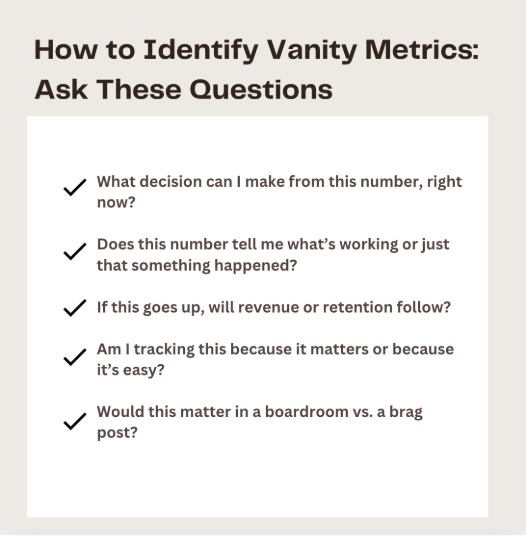



“Not everything that can be counted counts.” Albert Einstein
Yeah! he said that. Way back.
Before Shopify dashboards, before TikTok, before email open rates were even a thing. Honestly, he probably didn’t expect we’d be quoting him to roast our vanity metrics in ecommerce, but here we are.

Anyway,
You know that warm fuzzy feeling you get when you see 85,000 email opens? or when your TikTok video gets a few hundred thousand views overnight? or maybe when your app downloads spike after a paid campaign?
Yeah… feels good. But here’s the thing, it means nothing if no one’s buying.
Did you know?
6 in 10 marketing heads can’t prove impact because they track the wrong metrics; 40 % say they default to likes, impressions, or traffic instead of revenue or retention.
And yet, here’s what most marketers are still chasing:
60% of marketers say their top goal for the next 12 months is ‘increasing traffic.’ And 59% say their primary KPI is… also traffic.
And in a recent LinkedIn post, Rand Fishkin: CEO and co-founder of SparkToro, didn’t sugarcoat it:
“Traffic is a terrible goal. And it’s getting worse every year.”
He called it what it is: a vanity metric.
So why do we still chase these numbers?
Because they’re easy to show off. They look great in a screenshot. They also kinda give us confidence. Not to mention, the instant gratification, a viral tweet or a five-figure reach, is understandably hard to ignore.
But ask yourself: can I actually make a decision off this? Can I do something with it tomorrow? Or Will this help me sell more, retain more, or run leaner?
If not? then yeah, it’s probably vanity.
So, let’s detox that dashboard a bit.
In the next few minutes, we’re going to break down: what, why and who.
Because followers don’t pay bills. Revenue does.
Let’s get into it.
To keep it simple, vanity metrics are the numbers that show you something’s happening but not always something useful.
By definition, Vanity metrics are performance indicators that appear impressive on the surface but lack meaningful insight into business outcomes or decision-making. They don’t reflect the true health, growth, or efficiency of your business.
They’re the easy-to-spot, easy-to-report metrics. They can show attention. Visibility. Volume. But alone? They don’t answer the most important question:
Is this helping me drive revenue, customer retention, or better decisions?
Let’s walk through each of these and why they might look useful at first, but need more context to really mean something:
“Hey, we got 100,000 visits last month!”
Sounds great, but did they buy anything? Did they stay longer than 5 seconds?
Website visits only tell you that people showed up. Not who they were, why they came, or what they did. It’s a good directional stat, but not a decision-maker on its own.
You know, according to IRP Commerce, the average eCommerce conversion rate across all industries and categories is 1.80% in June 2025. Which means, even if you had a thousand visitors, most of them aren’t buying.
You can have 20,000 page views and still no conversions. A high number here might just mean someone refreshed the page a few times or clicked around without purpose. It doesn’t tell you if they found what they needed or if they left confused.
This guy is tricky. Likes feel validating. The followers look impressive.
But unless you're tracking how many of those people actually click through, add to cart, or convert… it’s just surface-level engagement. It shows awareness, not outcomes.
It’s a nice milestone, sure. But here’s the thing:
Downloads don’t equal active users.
Now of course, this doesn’t happen to every app. Some categories like banking, ride-sharing, or social media see better retention.
But for most brands?
If people download your app, open it once, and never return...
That’s not growth. That’s just shelf space on someone’s phone.
This used to be one of the go-to metrics for email success. You send a campaign, open rates go up, and it feels like it worked. But now, Apple’s Mail Privacy Protection blocks accurate tracking by loading emails automatically. This makes open rates unreliable.
Getting people to sign up is important. But what matters more is what happens after.
Did they place an order? Come back again? If not, that sign-up is just a number on your sheet, not a customer who came back to you.
This tells you how many people might have seen your ad.
But just because it “reached” 500,000 users doesn’t mean it led to clicks, conversions, or sales. Great for awareness, sure. But don’t stop the analysis there.
That product video you posted got 40K views? Awesome.
But did it drive interest? Did viewers scroll down and add the item to their cart?
Views don’t always mean impact unless they’re followed by action.

Now that we’ve filtered out, let’s look at the signals, the metrics that actually help you grow.
Every metric tells a story. But some tell you what’s happening on the surface, while others help you understand what’s really driving growth.
Here’s a simple side-by-side to help you shift focus from what looks good to what moves the business forward:
Oh, and FYI, If you’re offering extended warranties or even thinking about getting one,
SureBright’s AI-powered product protection doesn’t just plug into your store.
It gives you a full picture of attach rates, AOV impact, and conversion lift tied directly to warranty placement and behavior. It helps you to connect the dots between warranty metrics and retail metrics.
In fact, we broke it down clearly, give it a read: Warranty Metrics Here? Retail KPIs There? Get a 360° View Through Interconnected Metric Lens
If you have any questions or looking for a warranty partner, we are here to help.
At the end of the day, it’s not about tracking more metrics.
It’s about tracking the right ones.
Vanity metrics might give you a quick confidence boost, but they rarely give you clarity. And in ecommerce, where margins are tight, customer attention is limited, and every click counts. So, the next time you look at your dashboard, ask yourself:
“Is this helping me grow or just making me feel good?”
Because growth doesn’t come from page views. It comes from smart decisions. Clean insights. And knowing which numbers are actually telling you the truth and acting on it.